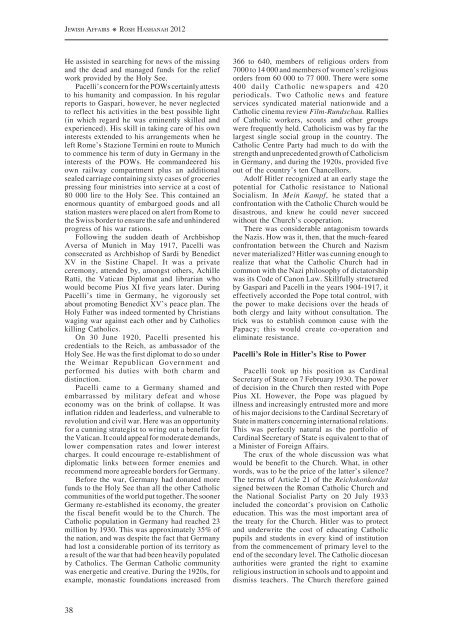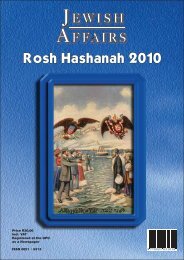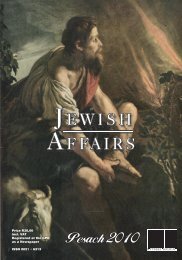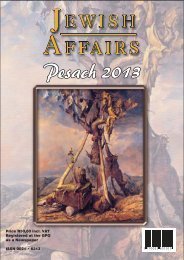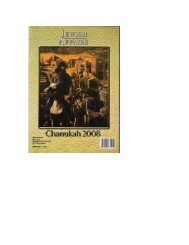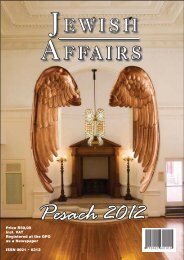Jewish Affairs - South African Jewish Board of Deputies
Jewish Affairs - South African Jewish Board of Deputies
Jewish Affairs - South African Jewish Board of Deputies
- No tags were found...
You also want an ePaper? Increase the reach of your titles
YUMPU automatically turns print PDFs into web optimized ePapers that Google loves.
JEWISH AFFAIRS ROSH HASHANAH 2012He assisted in searching for news <strong>of</strong> the missingand the dead and managed funds for the reliefwork provided by the Holy See.Pacelli’s concern for the POWs certainly atteststo his humanity and compassion. In his regularreports to Gaspari, however, he never neglectedto reflect his activities in the best possible light(in which regard he was eminently skilled andexperienced). His skill in taking care <strong>of</strong> his owninterests extended to his arrangements when heleft Rome’s Stazione Termini en route to Munichto commence his term <strong>of</strong> duty in Germany in theinterests <strong>of</strong> the POWs. He commandeered hisown railway compartment plus an additionalsealed carriage containing sixty cases <strong>of</strong> groceriespressing four ministries into service at a cost <strong>of</strong>80 000 lire to the Holy See. This contained anenormous quantity <strong>of</strong> embargoed goods and allstation masters were placed on alert from Rome tothe Swiss border to ensure the safe and unhinderedprogress <strong>of</strong> his war rations.Following the sudden death <strong>of</strong> ArchbishopAversa <strong>of</strong> Munich in May 1917, Pacelli wasconsecrated as Archbishop <strong>of</strong> Sardi by BenedictXV in the Sistine Chapel. It was a privateceremony, attended by, amongst others, AchilleRatti, the Vatican Diplomat and librarian whowould become Pius XI five years later. DuringPacelli’s time in Germany, he vigorously setabout promoting Benedict XV’s peace plan. TheHoly Father was indeed tormented by Christianswaging war against each other and by Catholicskilling Catholics.On 30 June 1920, Pacelli presented hiscredentials to the Reich, as ambassador <strong>of</strong> theHoly See. He was the first diplomat to do so underthe Weimar Republican Government andperformed his duties with both charm anddistinction.Pacelli came to a Germany shamed andembarrassed by military defeat and whoseeconomy was on the brink <strong>of</strong> collapse. It wasinflation ridden and leaderless, and vulnerable torevolution and civil war. Here was an opportunityfor a cunning strategist to wring out a benefit forthe Vatican. It could appeal for moderate demands,lower compensation rates and lower interestcharges. It could encourage re-establishment <strong>of</strong>diplomatic links between former enemies andrecommend more agreeable borders for Germany.Before the war, Germany had donated morefunds to the Holy See than all the other Catholiccommunities <strong>of</strong> the world put together. The soonerGermany re-established its economy, the greaterthe fiscal benefit would be to the Church. TheCatholic population in Germany had reached 23million by 1930. This was approximately 35% <strong>of</strong>the nation, and was despite the fact that Germanyhad lost a considerable portion <strong>of</strong> its territory asa result <strong>of</strong> the war that had been heavily populatedby Catholics. The German Catholic communitywas energetic and creative. During the 1920s, forexample, monastic foundations increased from366 to 640, members <strong>of</strong> religious orders from7000 to 14 000 and members <strong>of</strong> women’s religiousorders from 60 000 to 77 000. There were some400 daily Catholic newspapers and 420periodicals. Two Catholic news and featureservices syndicated material nationwide and aCatholic cinema review Film-Rundschau. Rallies<strong>of</strong> Catholic workers, scouts and other groupswere frequently held. Catholicism was by far thelargest single social group in the country. TheCatholic Centre Party had much to do with thestrength and unprecedented growth <strong>of</strong> Catholicismin Germany, and during the 1920s, provided fiveout <strong>of</strong> the country’s ten Chancellors.Adolf Hitler recognized at an early stage thepotential for Catholic resistance to NationalSocialism. In Mein Kampf, he stated that aconfrontation with the Catholic Church would bedisastrous, and knew he could never succeedwithout the Church’s cooperation.There was considerable antagonism towardsthe Nazis. How was it, then, that the much-fearedconfrontation between the Church and Nazismnever materialized? Hitler was cunning enough torealize that what the Catholic Church had incommon with the Nazi philosophy <strong>of</strong> dictatorshipwas its Code <strong>of</strong> Canon Law. Skillfully structuredby Gaspari and Pacelli in the years 1904-1917, iteffectively accorded the Pope total control, withthe power to make decisions over the heads <strong>of</strong>both clergy and laity without consultation. Thetrick was to establish common cause with thePapacy; this would create co-operation andeliminate resistance.Pacelli’s Role in Hitler’s Rise to PowerPacelli took up his position as CardinalSecretary <strong>of</strong> State on 7 February 1930. The power<strong>of</strong> decision in the Church then rested with PopePius XI. However, the Pope was plagued byillness and increasingly entrusted more and more<strong>of</strong> his major decisions to the Cardinal Secretary <strong>of</strong>State in matters concerning international relations.This was perfectly natural as the portfolio <strong>of</strong>Cardinal Secretary <strong>of</strong> State is equivalent to that <strong>of</strong>a Minister <strong>of</strong> Foreign <strong>Affairs</strong>.The crux <strong>of</strong> the whole discussion was whatwould be benefit to the Church. What, in otherwords, was to be the price <strong>of</strong> the latter’s silence?The terms <strong>of</strong> Article 21 <strong>of</strong> the Reichskonkordatsigned between the Roman Catholic Church andthe National Socialist Party on 20 July 1933included the concordat’s provision on Catholiceducation. This was the most important area <strong>of</strong>the treaty for the Church. Hitler was to protectand underwrite the cost <strong>of</strong> educating Catholicpupils and students in every kind <strong>of</strong> institutionfrom the commencement <strong>of</strong> primary level to theend <strong>of</strong> the secondary level. The Catholic diocesanauthorities were granted the right to examinereligious instruction in schools and to appoint anddismiss teachers. The Church therefore gained38


